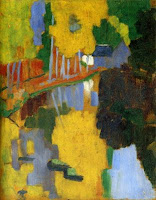On
November 24, 2019 at George Washington University’s Lisner Auditorium in
Washington, DC, the Dresser attended Washington Concert Opera’s production of Ambroise
Thomas’ three-hour opera Hamlet. WCO last
presented this Hamlet in 1998. Since
2002, Anthony Walker has served as Artistic Director and Conductor of this
robust musical group now in its 33rd season.
By robust,
the Dresser means this—on stage for this production, there were 55 musicians,
40 chorus members, a cast of 9 (two who double) and one very active and enthusiastic
conductor.
What stood
out in this production for the Dresser was an exceptionally fine cast of
singers. Soprano Lisette Oropesa as Ophelia rocked the house with her finely
controlled coloratura numbers, especially Ophelia’s mad scene. South African baritone
Jacques Imbrailo as Hamlet musically exhibited a range of nuanced emotions
without the pyrotechnics Thomas awarded to Ophelia. The Dresser also thinks
that Thomas inadvertently tipped a disproportionate amount of attention to
Ophelia and that a director has to carefully choose the baritone playing Hamlet.
The Dresser
who had never heard work by Ambroise Thomas pauses here to wonder why Thomas
made the role of Hamlet a baritone and not a tenor. After all the ghost of his
father played most ably by Brian Kontes is a bass baritone and Hamlet’s uncle
Claudius (Tom Fox)—brother to and murderer of the dead king—is also a baritone.
Additionally, the more minor role of Polonius—father of Ophelia and Laertes—is bass
baritone (sung by Timothy Bruno). The Dresser wonders if the composer was
trying to make his opera as dark as possible by the high ratio of low tone singers—2
baritone and 3 bass singers.
Jonas
Hacker as Laertes provides a satisfying performance, but his tenor role was
minor. The Dresser loved the drunken grave diggers sung by tenor Matt Hill
(also sung the role of Marcellus) and bass baritone Matthew Scollin (also sung
the role of Horatio).
The only
other female voice in this opera is Hamlet’s mother Gertrude. Mezzo-soprano Eve
Gigliotti masterfully played that role. She has a powerful voice that she uses
well and the ability to show with a glance or a gesture what her character is
feeling.
Overall the
experience of hearing this opera by Ambroise Thomas was good but the Dresser
felt impatient with its many interludes. The musical interludes made the opera
seem overly long despite the calming effect felt by the end of the opera. The Dresser
also had to let go of comparing the libretto by Michel Carré and Jules Barbier
based on a French adaptation by Alexandre Dumas and Paul Meurice to William
Shakespeare’s major work of tragedy by the same name. Thomas’ opera cuts a lot
out of Shakespeare’s Hamlet, dulling the emotional trauma and psychological
complexity.
The next Washington Concert Opera will be Verdi's Simon Boccanegra on April 5, 2020.
The next Washington Concert Opera will be Verdi's Simon Boccanegra on April 5, 2020.
The
Dresser chooses “Kind of Blue” by Reuben Jackson to have the final word in this
review because the poem speaks to the knife-stabbing horror suggested by naming
the fictional character Norman Bates out of the film Psycho. In the WCO production, the audience does not get to see
even a knife among these tuxedo-wearing men not to mention that Hamlet is
positioned far from Claudius. Jackson’s final stanza also summons in the Dresser’s
mind Ophelia, who in the flower of her youth drowns herself leaving Hamlet
alone with his broken heart and erstwhile
blues, blues that started with the death of his father.
KIND OF
BLUE
You feel
bad
And you feel
bad about
Feeling bad
And you
feel bad
Because your
erstwhile blues
Cause some
to scatter
As if you
forgot to wash
Or as a
sagacious sister
Said in
group therapy—
“People act like you going to get all Norman Bates on
“People act like you going to get all Norman Bates on
them and shit!”
And if you
are like me
You blame
yourself
The way
you blamed yourself for falling in love
With things
which further distance you from your peers,
the planet
Then a
rain-soaked rosebud appears
Or your
broken heart holds hands with a cello
And there
is no one to see you smile
by Reuben
Jackson
from
Scattered Clouds
Photo credit:
Don Lassell










